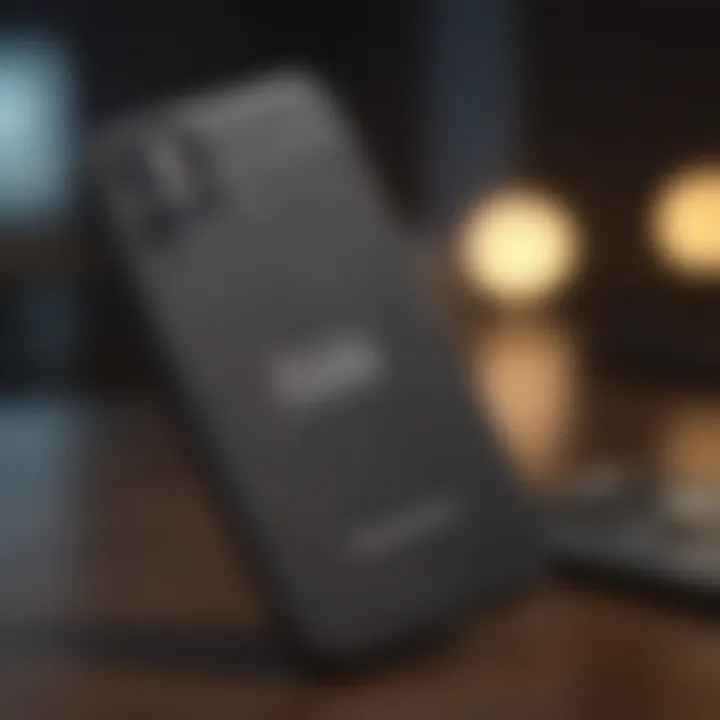Exploring the Best iPhone Insurance Options Available


Intro
In a world where smartphones have become indispensable, protecting your device is crucial. For many, the iPhone represents a significant investment, making the right insurance policy a necessity rather than a luxury. This article navigates the various options available for iPhone insurance, analyzing features, types, and reputable providers. Understanding the best insurance options is essential. The decisions you make can shield you from potential losses, thereby enhancing your overall user experience.
Overview of Financial Product
Definition
iPhone insurance is a financial product designed to protect users against the risks associated with damage, theft, or loss of their devices. Unlike warranties, which may cover mechanical defects, insurance often extends to scenarios that are more damaging to the phone's value and usability.
Key Features
Some significant features of iPhone insurance include:
- Accidental Damage Coverage: This covers unexpected incidents such as drops or spillages.
- Theft Protection: It helps in recovering or compensating for stolen devices.
- Repair Services: Many policies offer access to professional repair services.
- Loss Coverage: Compensation for devices lost under specific circumstances.
Purpose and Benefits
The primary purpose of iPhone insurance is to provide peace of mind. Users are safeguarded against hefty replacement costs. The benefits of having insurance include:
- Financial Security: Reduces the risk of significant out-of-pocket expenses.
- Convenience: Offers easy access to repair services without financial stress.
- Coverage Variety: Many policies can be tailored to individual needs.
Types and Categories
Insurance Types
Different types of insurance policies are available for iPhone users:
- Comprehensive Plans: Cover a wide range of incidents, including accidental damage and theft.
- Basic Plans: Focus more on theft and loss, with limited coverage for damages.
- Carrier Insurance: Offered by mobile carriers, typically tailored to specific devices.
Pros and Cons
Each type of insurance has its advantages and disadvantages. Some pros include the security of having coverage, while cons may involve complexity and understanding policy details.
Situational Uses
Understanding when to use iPhone insurance is crucial. For instance, if you frequently travel, comprehensive plans may prove beneficial. On the other hand, a basic plan may suffice for someone who rarely experiences accidents.
Application Process
Steps to Apply
Applying for insurance is often straightforward. The typical steps are:
- Research Providers: Look for well-reviewed insurance providers and understand their offerings.
- Choose a Plan: Select a plan that meets your financial and lifestyle needs.
- Complete Application: Fill out required forms, providing necessary details about your device.
Eligibility Requirements
Providers usually have basic eligibility requirements. Common aspects include:
- Proof of purchase of the iPhone.
- An active account with a service provider, if applicable.
Documentation Needed
Documentation often required for the application includes:
- Purchase receipt.
- Identification proof.
Common Mistakes to Avoid
Avoid these pitfalls:
- Not reading the fine print before signing up.
- Underestimating the importance of coverage specifics.
Tips for Success
To improve the likelihood of a successful application:
- Be thorough in gathering necessary documents.
- Research premiums and deductibles from various carriers, as these can differ significantly.
Costs and Fees


Types of Fees Associated
Understanding costs is vital. Common fees associated with iPhone insurance include:
- Monthly premiums.
- Deductibles for claims.
Comparisons of Costs Across Options
To help navigate costs, compare premiums and deductibles from various providers. It's essential to find a balance between coverage and affordability.
“Investing in iPhone insurance can ultimately save you money and provide peace of mind in an increasingly digital world.”
By evaluating your options, you prepare yourself to make informed decisions about your iPhone insurance. This comprehensive guide aims to illuminate the often-confusing landscape of smartphone insurance, ensuring you find the right fit for your unique needs.
Prolusion to iPhone Insurance
Defining iPhone Insurance
When we talk about iPhone insurance, we refer to financial protection plans that cover the costs of repair, replacement, or loss of an iPhone. These plans can vary greatly in terms of coverage, cost, and conditions. Some policies are offered by Apple itself, while others come from third-party providers. Understanding this cornerstone concept is crucial for users looking to safeguard their valuable devices. A clear definition sets the stage for exploring various options available in the market and helps users gauge what kind of coverage will best suit their needs.
Importance of Insuring Your iPhone
Insuring an iPhone holds significant importance for several reasons. Firstly, iPhones can be expensive investments. A top-tier model can cost several hundred dollars, making it practical to ensure that investment is protected. Without insurance, users may face hefty repair costs or, worse, the complete loss of their device in the event of theft or accidental damage.
Effective insurance can mitigate financial loss and provide peace of mind, allowing users to fully utilize their iPhones without fear of unexpected expenses.
Additionally, the reliance on smartphones for daily activities is growing. From work-related tasks to personal communication, our iPhones often act as a lifeline. Losing access to it can disrupt productivity and personal life. Therefore, having insurance can be seen as a necessary precaution rather than an optional expense. In this modern context, understanding the significance of iPhone insurance becomes a pivotal step in taking responsible ownership of a tech device.
Types of iPhone Insurance
Understanding the various types of iPhone insurance is essential for any iPhone user. With the growing dependency on these devices, protecting them becomes a priority. Different insurance options cater to varied needs. Knowing what each option offers can help in making a well-informed decision. Below are key types of insurance that are considered valuable for safeguarding your device.
Manufacturer Warranty
The manufacturer warranty is the standard coverage provided by Apple when purchasing an iPhone. This warranty typically lasts for one year and covers manufacturing defects but does not include accidents or damage caused by misuse. Understanding this warranty is crucial for iPhone users.
- Coverage Scope: It covers unexpected hardware failures but not accidental damage or theft.
- Duration: Generally, it expires after one year from the purchase date.
- Limitations: Users must be aware that once the warranty expires, repairs can become quite costly.
This warranty provides peace of mind to new iPhone buyers, but relying solely on it may not be sufficient. A user can incur significant expenses should any issues arise after the warranty period. Considering additional coverage may be wise, especially for those more prone to experiencing device mishaps.
AppleCare+
AppleCare+ is Apple’s extended warranty plan that offers more comprehensive coverage than the standard manufacturer warranty. It is a popular choice for many iPhone users and is designed to offer additional protection for their devices.
- Accidental Damage: AppleCare+ covers a certain number of accidental damage incidents, which includes screen repair.
- Extended Support: It not only extends the warranty period but also provides access to Apple’s technical support.
- Pricing: Users pay a monthly fee alongside a deductible when filing claims for device repairs.
The benefits of AppleCare+ make it attractive for individuals who want a blend of security and support. The coverage allows users to manage unexpected costs effectively and gain access to expert help with their devices. Given its features, many find this to be a sensible choice for long-term ownership.
Third-Party Insurance Providers
Third-party insurance providers present another option for iPhone coverage, often innovating unique plans that cater to different user needs. This type of insurance tends to offer a range of coverages, usually at competitive prices.
- Variety of Plans: Many third-party insurers provide various plans tailored to different risk profiles, such as loss or theft insurance.
- Flexible Pricing: These policies often feature different premium levels, allowing users to select plans based on their budgets.
- Claim Process: The efficiency and requirements for claims can vary greatly from one provider to another.
Users should carefully evaluate these options. Some may offer better coverage for specific incidents that AppleCare+ or manufacturer warranties do not cover. Yet, considering possible limitations and the claims process is key to ensuring satisfactory protection.
Key Features of iPhone Insurance Policies
Understanding the essential features of iPhone insurance policies is crucial for making an informed decision. Each feature adds to the protection and peace of mind for the user. By focusing on key aspects like accidental damage coverage, theft and loss protection, and battery replacement and repairs, individuals can assess their specific needs and choose a policy that fits their lifestyle and usage.
Accidental Damage Coverage
Accidental damage coverage is a fundamental aspect of iPhone insurance. It addresses incidents such as cracked screens, water damage, and other unintentional mishaps that can occur during daily use. This type of coverage is particularly important for active users or those who often transport their phones in various environments. The cost of repairs or replacements without insurance can be significant, often running into hundreds of dollars. Therefore, having this protection can save considerable expense and hassle, ensuring that the device remains functional even after an accident.
When evaluating policies, it's beneficial to examine the specific terms of the accidental damage coverage. Check for factors like the number of claims allowed within a year and any potential limits on payout amounts. Additionally, some providers may offer a more streamlined claims process, reducing downtime for the user.
Theft and Loss Protection
Theft and loss protection is another critical feature for iPhone users. With increasing concerns about smartphone theft, this feature provides reassurance. Insurance policies that cover theft typically reimburse the insured for the financial loss incurred when the phone is stolen. Some policies may even offer coverage for unauthorized charges made with the stolen device.
It is essential to recognize the requirements for making a claim under this coverage. Insurers often require a police report or incident report to process claims, which may extend the time before reimbursement is received. Inquire about waiting periods or additional steps needed, as these can significantly affect the claims experience. Knowing these intricacies beforehand can help users prepare adequately in case they face such unfortunate situations.


Battery Replacement and Repairs
Battery lifespan is a common concern for iPhone users, especially with frequent usage. Policies that include battery replacement and repairs can provide significant value. Not all insurance policies cover these aspects, so confirming this feature can help maintain the phone's performance. Over time, batteries lose capacity and may need professional replacement.
Understanding the terms regarding battery issues is important. Some insurers cover only battery failures due to defects, while others may assist with wear-and-tear problems too. Also, it is advisable to check whether the policy covers any associated labor costs for battery replacement.
Considering these features when selecting an iPhone insurance policy can ensure that users make prudent choices that cater to their specific needs and preferences.
Evaluating Insurance Costs
Evaluating the costs associated with iPhone insurance is crucial for making an informed decision. Insurance can represent a substantial expense, yet it offers valuable peace of mind. Understanding how premiums and deductibles affect your overall cost can influence which policy best fits your budget and needs. Evaluating insurance costs allows you to balance the potential financial burden against the coverage and benefits provided.
Premiums and Deductibles
Premiums are the regular payments you make for your insurance coverage. Typically, these are charged monthly or annually. A higher premium often correlates with more comprehensive coverage or lower deductibles. Conversely, a lower premium might require a higher deductible, which is the out-of-pocket amount you pay when claiming insurance.
Considerations about premiums include:
- Your budget and the frequency with which you can afford payments.
- The level of coverage you desire for your iPhone.
- How much you are willing to pay in case of a claim.
Deductibles represent a critical component of cost evaluation. A deductible is the amount you cover before your insurance kicks in. Higher deductibles usually lead to lower premiums, but they can create a financial hurdle when a claim is necessary. For example, if a policy has a deductible of $200, you must pay that amount out of pocket before coverage applies. Important to weigh the potential risks versus your ability to pay the deductible.
Assessing Value vs.
Cost
The relationship between value and cost in iPhone insurance is significant. This assessment requires reviewing the benefits of coverage against the money spent. A policy that seems inexpensive may not adequately protect against accidental damage or theft. Conversely, a more costly option might provide robust coverage that justifies the price.
To assess the value of your insurance, consider the following:
- Coverage Limits: How much the policy pays out in different situations. Higher limits often provide better protection.
- Additional Features: Policies may offer extras, like international coverage or lost phone protection, enhancing their overall value.
- Flexibility: Some providers allow customization of coverage based on your specific needs, which can add value.
When evaluating costs, remember to look beyond the price tag. A seemingly high premium might be more cost-effective in the long run if it provides adequate coverage for your smartphone.
Evaluating insurance costs is not simply about what you pay. It is about understanding the financial protection of your device against unexpected incidents. It is essential to consider both premiums and deductibles thoroughly, assessing how they impact the overall insurance value. Following this approach will better prepare you to make a choice that aligns with your requirements and financial circumstances.
Comparing Different iPhone Insurance Providers
When considering iPhone insurance, understanding the differences between various providers is vital. The insurance market features numerous options, each with various strengths and weaknesses. By assessing these factors, you can make informed decisions that suit your needs.
Customer Reviews and Ratings
One way to evaluate iPhone insurance providers is through customer reviews and ratings. These testimonials give insight into specific experiences of users with different companies. Positive feedback often indicates reliable service, while negative reviews can signal underlying issues. Look for patterns in the comments regarding claims processing, customer service, and overall satisfaction.
Tips for Researching Reviews
- Use multiple platforms to gather a range of opinions. Consider sites like Reddit and Facebook to find real user experiences.
- Pay attention to the date of reviews. Recent feedback provides a clearer picture of current service quality.
- Consider the ratio of positive to negative reviews. A predominance of complaints can be a red flag.
Claims Process Efficiency
The efficiency of the claims process is another crucial element. Filing a claim after an incident should be straightforward and quick. An inefficient process could lead to prolonged frustration and a lack of coverage at critical moments.
What to Look For
- Response Time: How quickly does the provider respond to claims? Effective insurers typically have established timelines for processing claims, often within a few days.
- Ease of Submission: A simple claims submission process, whether online or via app, can greatly enhance user experience.
- Resolution Rate: Check how many claims the provider successfully resolves. High resolution rates often correlate with customer satisfaction.
Provider Reputation
Finally, reputation matters immensely when choosing an iPhone insurance provider. A strong reputation often reflects years of reliability and customer service quality.
Evaluating Reputation
- Industry Recognition: Look at awards or accolades the provider has received for excellence in service.
- Financial Stability: Research the provider’s financial health to ensure they can fulfill their obligations. A well-capitalized insurer is more likely to pay out on claims.
- Market Presence: Consider how long the provider has been in the market. Longevity can indicate trustworthiness and adaptability over time.
Understanding these elements can help you choose a provider that offers not just competitive rates but also solid coverage and service. By comparing reviews, claims processes, and reputations, you can feel more confident that your investment in iPhone insurance will be protected.
Understanding Exclusions and Limitations
Understanding the exclusions and limitations of iPhone insurance policies is crucial for any potential policyholder. Many buyers focus on the coverage offered, but they often neglect to consider what is not included in their plan. By understanding these factors, users can avoid unpleasant surprises and ensure that they have appropriate protection for their device.
Moreover, exclusions and limitations play a significant role in determining the overall value of an insurance policy. Customers should examine these details thoroughly before making a decision. A policy might seem appealing at first glance, but hidden restrictions can impact the effectiveness of the coverage provided.


Knowing what is covered and what is not ensures that you make the right choice. It could save you time and money when you need to file a claim for damage or theft.
Common Exclusions
Typically, iPhone insurance policies have a list of common exclusions. Understanding these exclusions helps pretential customers gauge the reliability of a policy. Here are some typical exclusions you might encounter:
- Cosmetic Damage: Many policies do not cover scratches, dents, or other cosmetic imperfections that do not affect the functionality of the device.
- Water Damage: Most plans will exclude coverage for water damage, even if accidental. Customers need to take special care to protect their devices from liquids.
- Intentional Damage: Any damage that is caused intentionally or as a result of misuse is usually not covered. For example, throwing the phone across the room can void coverage.
- Unauthorized Repairs: If a user takes their iPhone for unauthorized repairs, any issues arising from that action may not be compensational.
When looking for insurance, it is important to read and understand the full terms of the policy to avoid falling in traps related to these exclusions.
Policy Limitations
Alongside exclusions, insurance policies often come with various limitations. These limitations can affect how and when you can file a claim. Here are some common limitations to be aware of:
- Claim Limits: Many policies place a cap on the total number of claims you can file within a specific period, often annually. Exceeding this limit can leave you without coverage.
- Device Age Restrictions: Some providers have age restrictions for the device being insured. For example, if your iPhone is older than two years, coverage may not be available.
- Coverage Restrictions on Accessories: While the insurance may cover the iPhone, accessories such as cases or chargers might not be included in the policy.
- Higher Deductibles for Certain Claims: Depending on what you are claiming for, there could be higher deductibles that may not make it worthwhile to file a claim.
How to File a Claim
Filing an insurance claim is a crucial step when your iPhone is damaged, lost, or stolen. Understanding this process allows you to ensure the protection you have invested in truly works for you. Knowing the right way to file a claim can save time and reduce stress when facing an unfortunate incident. Clarity on the steps involved can lead to a swifter remedy. Hence, we can break this down into two main areas: documentation required and the timeline for claims processing.
Documentation Required
When you need to file a claim, the first step involves gathering necessary documents. Having the right paperwork ready can significantly expedite the filing process. Generally, you should prepare the following:
- Proof of Purchase: This document confirms that you own the iPhone that requires insurance coverage. A receipt or email confirmation works well.
- Claim Form: Most insurance providers offer a specific form to fill out when submitting a claim. This can usually be found on their website.
- Photos of Damage or Theft: Visual evidence can support your claim. For damage, clear images showing the extent are important. If your device was stolen, documenting the location can also help.
- Police Report: In cases of theft, a police report is often required. This shows that you reported the incident.
- Previous Claims: If you have made claims in the past, having information about those can be useful. This will provide context to the provider about your claim history.
Completing these steps carefully will not only make your claim more efficient but also boost your chances of approval. Lack of proper documentation may lead to delays or even denial of your claim.
Timeline for Claims Processing
Understanding how long claims processing takes is valuable. Typically, this can vary based on the insurance provider and the particular circumstances of each case. Here are some general points to consider regarding the timeline:
- Initial Acknowledgement: Most insurance companies send an acknowledgment within a few days after you submit your claim. This usually means that they are reviewing your documents.
- Review Period: The thorough examination of your claim can take anywhere from a few days to a couple of weeks. During this time, they may contact you for additional information.
- Resolution: Once the review is complete, you will usually receive a decision. This can range from immediate approval to possibly requiring more documentation.
- Payout: If approved, the payout can happen quite quickly, especially in cases of mobile repair services. Generally, direct deposits are faster than checks via mail.
It is essential to maintain communication with your provider during this period. In case of delays, follow up to understand where your claim stands. This proactive approach helps ensure your claim is processed efficiently.
Frequently Asked Questions
Frequently asked questions play a significant role in this article as they address common concerns and misconceptions surrounding iPhone insurance. This section aims to provide clarity on critical aspects that many users ponder. By answering these questions, readers can gain a more nuanced understanding of their options, helping them navigate the insurance landscape effectively. Rational considerations regarding coverage can directly influence the decision-making process.
Is iPhone Insurance Worth It?
When evaluating the worth of iPhone insurance, it is essential to weigh potential risks against the costs associated with coverage. iPhones are often a considerable financial investment. Therefore, the prospect of damage, theft, or accidental loss looms over many users.
The decision on whether or not to purchase insurance should factor in the following:
- Repair Costs: The price for repairing a cracked screen can be substantial, often exceeding a couple of hundred dollars.
- Replacement Costs: In the event of total loss, replacing an iPhone can be a significant expense. Insurance can mitigate this financial burden.
- Coverage Features: Does the insurance policy cover accidental damage, battery issues, or theft? The comprehensiveness of the policy is critical to its value.
- Personal Usage: If the phone is used frequently in environments where it may suffer damage, insurance may be a wise investment.
Ultimately, many users find that the peace of mind offered by insurance can offset its costs, especially considering the high value of an iPhone.
*"Purchasing insurance can often seem like an unnecessary expense, but considering the potential costs of repairs and losses, it is worth evaluating thoroughly."
Can Buy Insurance After Purchase?
Many users wonder if they can still secure insurance for their iPhone after its initial purchase. This question often varies based on the type of insurance.
- AppleCare+: Users generally have 60 days from the date of purchase to enroll in AppleCare+. If you miss this window, you may not be able to obtain this specific coverage.
- Third-Party Insurance: Most third-party providers offer flexibility and enable users to purchase insurance even after they have obtained their device. However, eligibility conditions may apply.
- Existing Damage: If your iPhone has existing damage, obtaining coverage might become complicated or even impossible.
It is wise to check with the specific provider as some allow post-purchase insurance under certain conditions. This information highlights the importance of assessing insurance needs right at the point of purchase to avoid lapses in coverage.
Culmination
In the final analysis of iPhone insurance, understanding its relevance is key for anyone who values their device. iPhone insurance is not merely an added expense; it affords peace of mind. For young professionals, families, and students, the necessity of protecting a significant investment cannot be overstated. The extensive usage of smartphones in everyday life makes them susceptible to damage, theft, or unexpected techniqal issues.
Readers can glean insight from key elements such as the types of insurance, comparison of providers, and the inherent features each policy offers. The right coverage saves money in the long run. Furthermore, by knowing about necessary documentation and the claims process, users can navigate problems more efficiently.
"Investing in insurance can be as vital as purchasing the device itself. The right coverage can mitigate potential losses and provide reassurance."
Ultimately, comprehending the intricacies of iPhone insurance leads to informed decisions. The objective is to find a plan that provides comprehensive coverage while aligning with individual needs and budgets.
Key Takeaways
- Understanding Risks: Familiarize yourself with the risks associated with smartphone ownership. Damage and theft are common occurrences.
- Coverage Matters: Not all insurance policies are created equal. Evaluate features like accidental damage, theft protection, and battery issues.
- Cost vs. Value: Weighing the cost of premiums against potential financial loss from device damage is crucial. A high premium may offer better coverage.
- Reputation Counts: Research the providers. Customer reviews and claim process efficiency should guide your selection.
- Know the Exclusions: Understand common exclusions or limitations to avoid surprises when filing a claim.
Final Recommendations
- Assess Your Needs: Determine what coverage best suits your lifestyle. If you travel frequently, a policy with loss protection may be vital.
- Examine Plans Thoroughly: Don’t rush the selection process. Look for detailed information about each policy you consider.
- Consider Bundling: If you have other devices or insurance needs, look for options to bundle policies for savings.
- Stay Updated: Review your insurance policy annually or when you get a new device to ensure it still meets your needs.
- Reach Out for Help: If uncertain, consult with insurance experts or utilize online resources like Reddit or forums for additional insights.



